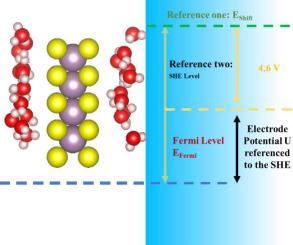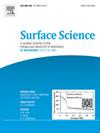First-principles investigation of electrified monolayered MoS2/water interface
IF 1.8
4区 化学
Q3 CHEMISTRY, PHYSICAL
引用次数: 0
Abstract
We investigate electrochemical properties of electrified MoS/water interface under applied bias potential. We show that water molecules rearrange depending on whether the surface is positively or negatively charged. A positive charge pulls water’s oxygen atoms closer to the surface, while extra electrons make water flip so that hydrogen atoms get nearer the surface. Abrupt changes are observed in the double layer charge and in the capacitance evolution as a function of bias potential and are explained by semiconductor nature of the MoS material. Overall, our findings confirm earlier results on the water dynamics at electrified metal–water interfaces and highlight that using explicit and hybrid modeling approaches helps to capture the fine details of electrochemical processes at solid/liquid interfaces.

带电单层MoS2/水界面的第一性原理研究
研究了在外加偏置电位作用下,电化二硫化钼/水界面的电化学性质。我们表明水分子的重新排列取决于表面是带正电荷还是带负电荷。正电荷使水的氧原子更靠近表面,而额外的电子使水翻转,使氢原子更靠近表面。观察到双层电荷和电容随偏置电位的突变,这可以用二硫化钼材料的半导体性质来解释。总的来说,我们的研究结果证实了之前关于带电金属-水界面水动力学的结果,并强调使用显式和混合建模方法有助于捕捉固体/液体界面电化学过程的细节。
本文章由计算机程序翻译,如有差异,请以英文原文为准。
求助全文
约1分钟内获得全文
求助全文
来源期刊

Surface Science
化学-物理:凝聚态物理
CiteScore
3.30
自引率
5.30%
发文量
137
审稿时长
25 days
期刊介绍:
Surface Science is devoted to elucidating the fundamental aspects of chemistry and physics occurring at a wide range of surfaces and interfaces and to disseminating this knowledge fast. The journal welcomes a broad spectrum of topics, including but not limited to:
• model systems (e.g. in Ultra High Vacuum) under well-controlled reactive conditions
• nanoscale science and engineering, including manipulation of matter at the atomic/molecular scale and assembly phenomena
• reactivity of surfaces as related to various applied areas including heterogeneous catalysis, chemistry at electrified interfaces, and semiconductors functionalization
• phenomena at interfaces relevant to energy storage and conversion, and fuels production and utilization
• surface reactivity for environmental protection and pollution remediation
• interactions at surfaces of soft matter, including polymers and biomaterials.
Both experimental and theoretical work, including modeling, is within the scope of the journal. Work published in Surface Science reaches a wide readership, from chemistry and physics to biology and materials science and engineering, providing an excellent forum for cross-fertilization of ideas and broad dissemination of scientific discoveries.
 求助内容:
求助内容: 应助结果提醒方式:
应助结果提醒方式:


